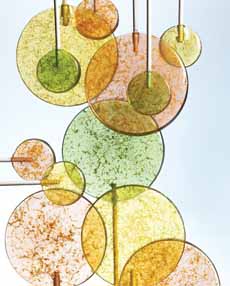FOOD HISTORY: The Lollipop
 [1] Artisan lollipops from Quevanna.  [2] European lollipop art (photo courtesy Williams-Sonoma).
|
July 20th is National Lollipop Day. According to the National Confectioners Association, eating sugar from a stick likely dates to prehistoric man, who licked honey off the stick he used to scrape it from the beehive. The ancient Arabs, Chinese and Egyptians made fruit and nut confections candied in honey, which may also have been eaten from sticks, owing to the stickiness of the confection. What we think of as a lollipop may date to Europe in the Middle Ages, when sugar was boiled—creating hard candy—and formed onto sticks as treats for the wealthy. They were the only people who could afford sugar. For that reason, the confection didn’t cross over to the mainstream. By the 17th century, sugar was plentiful and affordable. In England, boiled sugar (hard candy) treats were popular. The word “lollipop” (originally spelled lollypop) first appears in print in 1784, although it did not always apply to hard candy on a stick. It took a while, but in the U.S., on October 13, 1931, the name “Lolly Pop” was officially registered by the U.S. Patent and Trademark Office to the Bradley Smith Company of New Haven. The company began to produce Lolly Pops in 1908, but it took years to convince the Patent Office to grant an exclusive right to the name. Though lollipop is a generic term today, George Smith of the Bradley Smith Company was the first to apply it to hard candy on a stick. He was inspired by the success of a local confection being produced in West Haven called Reynolds Taffy, a chocolate caramel taffy on a stick (the type now made by See’s Candies). The name itself, Lolly Pop, was reportedly inspired by that of a racehorse Smith had seen at a local fair. Unfortunately, the Patent Office uncovered the old English term, lollipop, from 1784, where it was described as “a hard sweetmeat, sometimes on a stick.” They refused Bradley Smith’s initial registration. The trademark was finally granted after the company proved that Lolly Pop was an original spelling and its first use. During the long registration battle, other producers used the name freely until the Bradley Smith Company won its patent. Over the years the term Lolly Pop, and its variant spelling Lollipop, became interchangeable; and so universally used that the trademark could not be maintained (source). (Now you understand “Kleenex Brand Tissues” and “Sanka Brand Coffee” (italics ours). At the Bradley Smith Company, Lolly Pops were produced by cutting off a chunk of warm hard candy and pushing in a stick. This was all done by hand. In the process of inserting the stick, the candy was formed and slightly flattened out by the palm. Later, Max Buchmuller, a foreman at the company, invented and patented a machine to insert the sticks. The machine featured a continuous chain of split molds, which, when filled and closed, shaped the Lolly Pop. An automated plunger pushed the sticks into the candy. |
|
|
The Industrial Revolution had come to lollipops! The machines allowed the company to produce 125 pieces a minute. Mechanical improvements were made to keep up with demand, and pushed the production capacity to 750 Lolly Pops per minute. The first Lolly Pops sold for a penny. Bradley Smith distributed the sweets and around the world, shipping them everywhere from England to China (source). As lollipops evolved, they were made in shapes, embedded with flower designs (photo #3) or actual flowers, accented with gold leaf, inscribed with endearing expressions, and merged with other candies, like Tootsie Pops. Some artisan lollipops are raised to the level of art (photo #2). Whether you reach for art or a give-away lolly from the doctor’s office, enjoy National Lollipop Day! |
||
